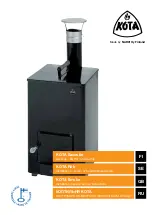
[9.1.3] Smoke Entry Test
To determine if smoke is capable of entering the sensing chamber, visually identify any obstructions. Plug the exhaust and sampling tube holes
to prevent ducted air from carrying smoke away from the detector head, then blow smoke such as cigarette, cotton wick, or punk directly at the
head to cause an alarm. REMEMBER TO REMOVE THE PLUGS AFTER THIS TEST, OR THE DETECTOR WILL NOT FUNCTION PROPERLY.
[9.1.4] Air Flow Test using Dwyer Series 607 Differential Pressure Transmitter
Verify the air speed of the duct using an anemometer. Air speed must be at least 100 FPM. Wire the Dwyer transmitter as shown in Figure 8. Connect
the leads of the meter to either side of the 1000
Ω
resistor. Allow unit to warm up for 15 seconds. With both HIGH and LOW pressure ports open to
ambient air, measure and record the voltage drop across the 1000
Ω
resistor (measurement 1), 4.00 volts is typical. Using flexible tubing and rubber
stoppers, connect the HIGH side of the transmitter to the sampling tube of the duct smoke detector housing, and the LOW side of the transmitter to
the exhaust tube of the duct smoke detector housing. Measure and record the voltage drop across the 1000
Ω
resistor (measurement 2). Subtract the
voltage recorded in measurement 1 from the voltage recorded in measurement 2. If the difference is greater than 0.15 volts, there is enough air flow
through the duct smoke detector for proper operation.
[9.1.5] Filter Replacement
The filters do not substantially affect smoke performance even
when up to 90% of the filter is clogged. Quarterly visual inspec-
tion usually suffices to determine whether the filters should be
replaced because only a high percentage of contamination
affects performance. If further testing is required, compare differ-
ential pressure readings with and without the filters installed. If
the difference exceeds 10% replace the filters. In no case should
the pressure differential fall below 0.0015 inches of water.
[9.2] Standby, Alarm, And Sensitivity Tests
[9.2.1] Standby And Trouble
Standby —
If programmed by the system control panel,
look for the presence of the flashing LEDs
through the transparent housing cover. The
LED will flash with each communication.
Trouble —
If programmed by the system control panel and if the detector LEDs do not flash, then the detector lacks power (check wiring, panel
programming, or power supply), the detector board is missing (replace), or the unit is defective (return for repair). Additionally, it the
cover is removed for more than 20 minutes, the LEDs of the detector will not flash.
Test —
The trouble condition can be caused intentionally to verify correct operation of the system. Remove the detector board to cause a
trouble condition locally and at the system control panel.
J500-41-00
6
I56-2199-003R
Figure 9. Wiring Diagram for DH300RPL Duct Smoke Detector
using a UL listed control panel
+
–
COM (+)
COM (-)
COM (+)
COM (-)
COMMUNICATION
LINE
UL LISTED CONTROL
PANEL
1ST DETECTOR
IN LOOP
2ND DETECTOR
IN LOOP
1 2
1 2
J1 JUMPER
J1 JUMPER
H0134-00
NOTE
: THE J1 JUMPER
MUST BE REMOVED
FOR POWER BOARD
SUPERVISION.
THE J1
JUMPER MUST
BE INSTALLED FOR 2W
APPLICATIONS
H0163-01
DIFFERENTIAL
PRESSURE
TRANSMITTER
MODEL #607-01
HIGH
LOW
TO SAMPLING TUBE
TO EXHAUST TUBE
VOLT METER
FLUKE MODEL 87
OR EQUIVALENT
1000 OHM 5% 1 WATT RESISTOR
9 VOLT
BATTERY
9 VOLT
BATTERY
9 VOLT
BATTERY
15 TO 36VDC
SUPPLY
Figure 8. Procedure for verifying air flow:


























